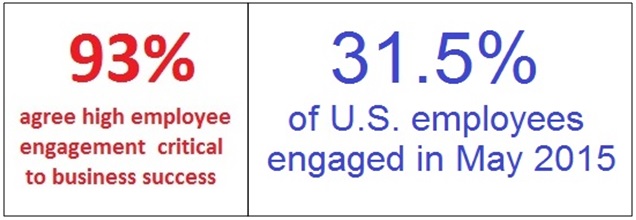 According to the Human Capital Institute’s More than a Number: Agile and Actionable Employee Engagement Measurement report, “[a] full 93% of respondents agree that high employee engagement is critical to business success.”1 Yet Gallup states that “[t]he percentage of U.S. employees engaged in their jobs averaged 31.5% in May.”2
According to the Human Capital Institute’s More than a Number: Agile and Actionable Employee Engagement Measurement report, “[a] full 93% of respondents agree that high employee engagement is critical to business success.”1 Yet Gallup states that “[t]he percentage of U.S. employees engaged in their jobs averaged 31.5% in May.”2
Obviously, there is a disconnect. So where are companies getting it wrong? They are concentrating their efforts on the easy, superficial options that allow them to say they are focused on employee engagement. Unfortunately, these attempts do little to address how to truly engage employees. Below is a list of some of options companies use to tout their commitment to employee engagement.
Engagement surveys – Companies ask their employees to complete long questionnaires on a yearly or bi-annual timeframe. Usually there is low participation because employees do not trust that their comments are anonymous. After completed, months pass before the results are finalized. Once the results trickle down to the employees – if they trickle down – action plans are created to try to address the issues uncovered in the survey. From that point, there is little follow-up on tracking the outcomes of those action plans.
Community volunteer programs – Employees want to feel like they are part of a larger purpose. Being involved on community programs can help. Companies fail in that they do not focus their volunteer efforts. Employees can get credit for volunteering anywhere. In the end, it is the company that claims the volunteer hours and employees are left with little more that the knowledge that they made a little difference in their community.
Corporate giving programs – Once a year companies collect money from employees on behalf of various organizations. The United Way, in my experience, has been the biggest beneficiary of these funds. While it is nice to know that you are supporting various charities, programs, etc. It is the company that takes credit for the funds collected. Again, employees are left with little more that the knowledge that they made a little difference.
Wellness programs – Programs that promote healthy lifestyles are popular. Employees may get assistance with gym memberships, smoking cessation, the tracking of steps to promote movement, etc. While these programs have the potential to benefit each employee, it is the work environment that dictates whether employees can take advantage of them. High stress environments won’t help a smoker quit. Gym time may be forgone because of excessive overtime or work needs.
Free meals – Who doesn’t like free food? The motive behind this offering is suspect. Does the company want to keep you in the office longer? Is the food nutritional and tied into any wellness program?
Open workspaces – In the latest craze, employees are exposed to each other and yet lack the privacy needed to be able to work effectively.
Games – Companies try to emulate startup companies by providing video games, table games (ping pong/pool), etc. in order to introduce a bit of fun into the work environment.
Happy Hours – Free alcohol is popular and a lot of companies rely on these types of events exclusively. They can be effective if the right leaders are present and if their purpose if more than just about the alcohol.
Discount programs – Some companies offer their employees savings from select companies.
Employee Referral programs – Many companies compensate their employees for referrals that are hired. While these programs can be beneficial, companies have to consider how their decisions can impact the engagement of referring employees and potential customers.
Employee Appreciation Days – Setting aside a day to celebrate employees is a short term option. The other work days will dictate how employees react to such days. Recognition should be incorporated into every leaders daily routine.
Benefits packages – Benefits packages tend to be one size fits all. More needs to be done to promote available benefits so that employees are knowledgeable of what is available to them.
Overtime pay – If you have hourly employees, there many who would welcome overtime opportunities. Companies must monitor over time hours so that employees are not overworked.
Paid vacation – Employees should be encouraged to take time off from their roles in order to recharge. If companies offer vacation, they should make sure that employees can take advantage of the time off.
None of the above will make you an employer of choice. They aren’t good or bad. They have the potential to engage employees if managed properly yet none would impact the effort an employee might give or play a part in an employee’s decision to leave a company.
To engage and retain employees, companies need to consider existing or potential programs based on the factors that impact employee engagement. These factors have no easy solutions and to address them will take time and much attention from everyone involved….and everyone should be involved!
Here are the four factors on which companies should focus their efforts:
The employee-manager relationship – Hire the right employees and train managers in how to become better leaders.
Recognition and rewards – Employees want to know that they are appreciated. Direct managers play an important role.
Growth and development opportunities – Employees want opportunities to build and hone their skills. They seek ways to improve their skills in order to make themselves more valuable to the company.
Advancement opportunities – In addition to growth and development opportunities, employees want to understand the career paths available and want to have the opportunity to take on larger, more challenging roles within the company.
Engaging employees isn’t easy and while there are factors that can have a great impact on engagement, companies choose implement superficial programs rather than digging in to the core issues.
How does your company demonstrate employee engagement? What programs have worked well? Not worked well?
1 Filipkowski, Jenna. “Human Capital Institute.” More than a Number: Agile and Actionable Employee Engagement Measurement -. Human Capital Institute, 27 May 2015. Web. 17 June 2015. <http://www.hci.org/hr-research/more-number-agile-and-actionable-employee-engagement-measurement>.
2 Adkins, Amy. “U.S. Employee Engagement Flat in May.” U.S. Employee Engagement Flat in May. Gallup, 9 June 2015. Web. 17 June 2015. <http://www.gallup.com/poll/183545/employee-engagement-flat-may.aspx>.
Let’s Engage!
I’m Agent in Engagement Simpson…Gregory F Simpson.
Employee engagement is a critical mission. I hope I can count on your help! Subscribe to the RSS Feed to receive the latest intelligence/insights and/or register to make entries in the comments log.
 You can follow me @agtinengagement.
You can follow me @agtinengagement.
Email me at g…@a…t.com.
Connect via LinkedIn at LinkedIn.com/in/GregoryFSimpson.
Learn more about me at gregoryfsimpson.com.
P.S. First contact? Welcome to the Agent In Engagement community. Explore and join fellow employee engagement operatives in targeting a known thief – alias: Disengagement. Together we can bring this thief to justice and make the world a better place for all companies and their employees.
Other recent Agent in Engagement data/reports by Agent Gregory F Simpson:
- Employee Engagement Intelligence Briefing: 2015.06.08 – 2015.06.12
- Veteran Employee Engagement Operative Insights: 06.01 – 2015.06.05
- The Engaging Questions
- Manhattanhenge and Engagement
- Employee Engagement Requires ‘A Curious Mind’
- The Hortons and The Whos of Employee Engagement
- Employee Engagement and “The Customer Rules”